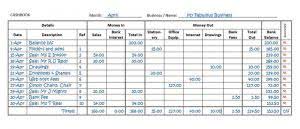
As mentioned above, the per unit variable cost decreases with the increase in the level of production. The contribution margin represents the revenue that a company gains by selling each additional unit of a product or good. https://www.bookstime.com/articles/outstanding-checks This is one of several metrics that companies and investors use to make data-driven decisions about their business. As with other figures, it is important to consider contribution margins in relation to other metrics rather than in isolation. The contribution margin can help company management select from among several possible products that compete to use the same set of manufacturing resources.
- As mentioned above, the per unit variable cost decreases with the increase in the level of production.
- The electricity expenses of using ovens for baking a packet of bread turns out to be $1.
- After almost a decade of experience in public accounting, he created MyAccountingCourse.com to help people learn accounting & finance, pass the CPA exam, and start their career.
- The following are the steps to calculate the contribution margin for your business.
- Furthermore, an increase in the contribution margin increases the amount of profit as well.
Table of Contents
Income Statement
- This metric is typically used to calculate the break even point of a production process and set the pricing of a product.
- The contribution margin ratio represents a company’s revenue minus variable costs, divided by its revenue.
- This means the higher the contribution, the more is the increase in profit or reduction of loss.
- However, this strategy could ultimately backfire, and hurt profits if customers are unwilling to pay the higher price.
If the contribution margin for an ink pen is higher than that of a ball pen, the former will be given production preference owing to its higher profitability potential. The contribution margin can be stated on a gross or per-unit basis. It represents the incremental money generated for each product/unit sold after deducting the variable portion of the firm’s costs.

What is the Contribution Margin Used For?
- In the Dobson Books Company example, the contribution margin for selling $200,000 worth of books was $120,000.
- In other words, your contribution margin increases with the sale of each of your products.
- Accordingly, you need to fill in the actual units of goods sold for a particular period in the past.
- Alternatively, the company can also try finding ways to improve revenues.
- Management must be careful and analyze why CM is low before making any decisions about closing an unprofitable department or discontinuing a product, as things could change in the near future.
The contribution margin income statement separates the fixed and variables costs on the face of the income statement. This highlights the margin and helps illustrate where a company’s expenses. Variable expenses can be compared year over year to establish a trend and show how profits are affected. The contribution margin measures how efficiently a company can produce products and maintain low levels of variable costs. It is considered a managerial ratio because companies rarely report margins to the public. Instead, management uses this calculation to help improve internal procedures in the production process.
The Financial Modeling Certification

Contribution margin is used to plan the overall cost and selling price for your products. Further, it also helps in determining profit generated through selling your products. A key characteristic unearned revenue of the contribution margin is that it remains fixed on a per unit basis irrespective of the number of units manufactured or sold. On the other hand, the net profit per unit may increase/decrease non-linearly with the number of units sold as it includes the fixed costs. Dobson Books Company sells textbook sets to primary and high schools.
Fixed Costs vs. Variable Costs
This is because the contribution margin ratio indicates the extent to which your business can cover its fixed costs. Suppose Company A has the following income statement with revenue of 100,000, variable costs of 35,000, and fixed costs of 20,000. The contribution margin ratio represents a company’s revenue minus variable costs, divided by its revenue.

Remember, that the contribution margin remains unchanged on a per-unit basis. Whereas, your net profit may change with the change in the level of output. Contribution margin calculation is one of the important methods to cm ratio evaluate, manage, and plan your company’s profitability. Further, the contribution margin formula provides results that help you in taking short-term decisions. Investors examine contribution margins to determine if a company is using its revenue effectively.
- Contribution margin calculation is one of the important methods to evaluate, manage, and plan your company’s profitability.
- However, this implies that a company has zero variable costs, which is not realistic for most industries.
- In the past year, he sold $200,000 worth of textbook sets that had a total variable cost of $80,000.
- Thus, you will need to scan the income statement for variable costs and tally the list.
- However, these fixed costs become a smaller percentage of each unit’s cost as the number of units sold increases.
- Furthermore, the variable costs can be either direct or indirect.
Formula and Calculation of Contribution Margin

The best contribution margin is 100%, so the closer the contribution margin is to 100%, the better. The higher the number, the better a company is at covering its overhead costs with money on hand. The profitability of our company likely benefited from the increased contribution margin per product, as the contribution margin per dollar increased from $0.60 to $0.68. Next, the CM ratio can be calculated by dividing the amount from the prior step by the price per unit.
